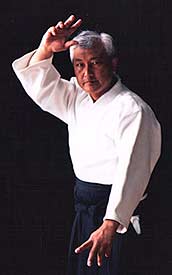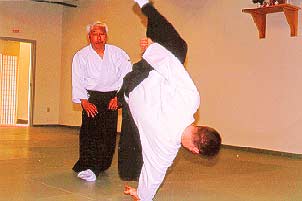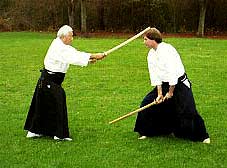What Is Aiki Jujutsu?

By Okabayashi Shogen Shihan, Founder of Hakuho ryu Aiki-Budo
Translated
by Russel Haskin
Editor’s Note: The following is
an edited excerpt from a speech given by Okabayashi Sensei given at his
organization’s
annual Fukuoka seminar several years ago. Okabayashi offers a unique
vantage point to discuss aiki-jujutsu, having studied Daito ryu Aiki-jujutsu
under its two best known modern proponents, the late Takeda Tokimune,
36th Soke (son of Takeda Sokaku, 35th successor within the system who
first popularized the art), and Hisa Takuma, Menkyo Kaiden of Daito Ryu
(one of only two people Sokaku Sensei ever awarded this rank to). Daito-ryu
is the foundation art from which various schools of aiki-jujutsu trace
their lineage. Readers might also see: Seeking
The Original Path: An Interview With Daito-Ryu’s Okabayashi and Daito-Ryu.
It is very hard to express aiki-jujutsu in words, but I will give it
my best effort. I expect that everyone here wants to become stronger,
but have you ever considered exactly how strong is strong enough? Is
it enough to be the best or strongest in your neighborhood? Or would
you like to be strongest in your city? Or is it the strongest in the
State/prefecture? Maybe the country? This type of goal is what I call
a “relative” desire; it will disappear at the same time (and
only when) the “relative” existence does.
 |
Okabayashi Sensei throws an attacker almost effortlessly. |
In our organization there are people ranging from five to eighty nine
in age who are training diligently. Along these “relative” lines,
if there were a competitive arena that recognized 89 year old fighters,
our 89 year old practitioner would definitely be in the top fifty in
the country. Most definitely he would be number one in the prefecture.
However, in reality this is not the level or reasoning with which we
train. This is because aiki-jujutsu requires us to have the idea of capturing
the single “absolute” moment in time and space that exists
for just a split second in any relative situation. Everyone here has
probably experienced at some time or another in their lives the realization
of just how prevalent these concepts of relativity are in everything
we do.
Aiki-jujutsu is fundamentally different from other fighting arts because
of the very fact that it doesn’t put its main emphasis in relative
principles, but rather it puts its focus on how to benefit from capturing
this “absolute” instant of time and space created somewhere
during the period of mutual contact between you and the opponent.
Understanding the concept that aiki-jujutsu is not a thing that requires
you to have “relative” strength should be your first priority.
It is the idea that says it is not how strong you are in relation to
your opponent, but rather as long as your opponent is a person who lives
in the “world of relativity,” no matter how strong he is
you will somehow prevail. This is a very difficult way of thinking, but
without gaining an understanding of the real truths contained in it,
aiki-jujutsu is impossible. In fact you could say that this is the true
principle of aiki. The purpose of our training is to capture or try to
capture this absolute interval of time and space; both created and extinguished
in a single instant. As an end result the opponent may be thrown or taken
down, but making a throw or pinning someone is not the goal, and relying
on strength is something that, although necessary in jujutsu practice,
only becomes a hindrance in aiki-jujutsu practice. (1)
If you were able to use the two interchangeably you would probably become
very strong in competition. This is a vitally important point: the shoden
(118 basic techniques) (2) in our aiki-budo is made up of jujutsu and
therefore touches on things that are recognizable to the competitive
world of the strong; i.e. the “relative world.”
Editor’s Note: Okabayashi now uses the term aiki-budo rather than
Daito-ryu. He changed the name because he felt the philosophical and
historical foundations of the style as practiced in many modern organizations
has diverged from the original. Okabayashi also wanted to avoid the politics
of the art and as confusion with other groups that practice aiki-jujutsu
techniques using modern body movements, or those groups born from totally
different origins that are Daito-ryu in name only.
The Chuden level (the level of techniques above shoden) (3) of aiki-no-jutsu
is something that enters into an area that goes beyond the relative.
To teach aiki to a youth whose body is not yet trained and whose spirit
is still soft and weak will not amount to anything useful. Jujutsu is
much better for gaining control of one or two unreasonable people. People
who are young and have the strength of youth quickly become enchanted
with these strong competitive aspects of jujutsu. However, it is no good
to push on to go further in your training at this relative level. While
training yourself and your body to a certain level in the relative world,
you need to start your quest for the absolute world.
At right, Okabayashi demonstrates a technique from
Onno-ha Itto-ryu Kenjutsu. Students within Hakuho-ryu also study
this art since it is complementary to the aiki-jujutsu taught.
Both too utilize the same principles of body movement – relaxation
of external musculature, moving along a single line while eliminating
any body twist, along with the use of gravity and the internal
hinges of the body to create the driving force behind most movement.
This
unique movement, once central to advanced levels of the classical
sword, is very different from the body movement now found within
modern martial arts including jujutsu. |
 |
Older practitioners, because they have an abundance of
life experiences to draw from, are at a point where they can understand
the idea of incorporating
this created “absolute world,” and this “absolute moment” of
time and space into their jujutsu. This is the practice of aiki-jujutsu.
This flexibility in the technical makeup of aiki-budo (using aiki-jujutsu)
is a magnificent thing. Even though we say that the shoden techniques
are jujutsu, they are designed in such a way that by adding or reducing
strength and power, moving faster or slower, drilling with or without
putting in aiki, many various types of practice are possible. From the
time someone enters the Hakuho ryu we explain the idea of aiki in an
easy to understand way, make clear the foundational principles of Kobudo
(the classical fighting arts of Japan); and incorporate the concepts
of aiki into our jujutsu to train in aiki-jujutsu. Even this does not
seem to prevent people from being stiff and using strength, and this
usually causes them to forget other very important elements such as angles,
skin sensitivity, and breathing.
Trying to steal (understand) (4) technique from things like video is
almost the same; you cannot understand anything deeper than the points
of the form you see. However, even if you practice at this lowest level
by using only the form and your own strength, you can become very strong
in the relative world. If you were to practice just one hour a day, every
day for three years, you would become quite strong. If you consider the
fact that in the relative would various rules exist, you could probably
ready a level high enough for you to make a living from life in the ring.
You can train your body to quite a formidable level of strength by using
the shoden of aiki- jujutsu also. No matter how strong you train the
muscles in your body, however, it is of little value when it comes to
using aiki. This is because aiki is a system made for negating strength
(external), and therefore it is impossible to remain in the world of
relative strength and do aiki. Also, in order for you to understand aiki
it is necessary for you to transcend the idea of winning or losing.
While fully acknowledging this, however, practitioners still have a
tendency to dwell on winning and losing. In reality it is this dwelling
on winning and losing that forms an unnecessary barrier to their real
progress.
I would like everyone to change their consciousness away from this idea
of who is number one, two, etc., and try to capture the phenomena of
the “absolute moment.” It is a pursuit that is very different
from the fighting arts that compete over who is number one, or two; 5,000
or 5,001. The first priority you have is self-defense. There is no room
for the entry of relative matters of strong or weak in self-defense situations.
Rather, no matter how weak a person may seem or how strong they make
themselves out to be, you must train mastery over them in the same way.
Along these lines it was originally not allowed to show even one part
of a technique to someone outside your fellow disciples. This was because
you did not want to give your opponent the ability to even imagine what
type of technique you might use.
If the opponent were to know a technique of yours, he could imagine
the ways you might respond, and from this figure out the best way to
attack you. In order for you to be able to defend yourself against any
type of opponent you must capture the absolute moment. This “absolute
moment” is NOT the same as a “suki” or opening in your
opponent (his technique, stance or position). In response to the opponent’s
attack you must create this “instant” by causing an effect
in the attacker. This effect has no form, leaves nothing remaining after
it passes, and is something that should disappear in an instant. However,
it is something that is definitely created; a work of art that appears
for just a moment. The second priority for you should be this fine art
of finding a way to create the “absolute moment.”
Perhaps the reason we only see the occurrence of aiki (real aiki) in
Japan lies in the traditional way our ancestors lived without carrying
any offensive or attacking nature. Arts that contain these traditional
roots and follow this path are what we should call Kobudo. Should aiki-jujutsu
or daito-ryu groups that inorganically combine one technique to another
and move with modern sport-like twisting of the body really call themselves
aiki-jujutsu or daito-ryu? At the very least we must not confuse ourselves
with these people who copy only the outer layer of its technique.
To know only the form of a technique is not sufficient. You should try
to get to the bottom of the very roots that make up the technique and
then begin to work on using it. I have said before that you can become
strong just with jujutsu, but it is also necessary for you to gain an
understanding of the reasons why the kata (separate technique sequences)
(5) have the effects they have on the attacker. Failing to do this will
block your path to understanding aiki. This requires that you continue
to keep reducing the amount of strength you use in your technique. Depending
on the strength you use, the ability of your consciousness to capture
multi-faceted things such as angles and direction with your skin sensitivity
is cut down, and this prevents you from understanding the reasons behind
the technique.
There is a very old saying that says, “in winning there is a mysterious
victory.” This is to say that when you win with aiki by capturing
the absolute moment, there appears to be no obvious reason why you won.
To the onlooker who sees only relative differences such as weak and strong
this is mysterious. When you capture the ‘absolute moment,” this
goes beyond time and space and can therefore not be measured by shortness
of a single instant of the world of relativity. (6)
It could be said that this is the time when you cross with the spheres
of the supernatural: the aiki which causes and finishes the absolute
moment is like a vision or a phantom that has no real form or shape to
grab hold of. There is no place to capture or grab hold of because it
is such a mysterious place in time and space. Of course there are levels
in this aiki ranging from the artless, immature low level to the extremely
complex high level. In this sense, training is really the striving of
every individual practitioner to master the next higher level of aiki.
It is not a type of thing where you can say that because you have received
an explanation, you can reach the third level of aiki, or the fifth level,
etc.
In response to the physical nature of jujutsu, it may be better to say
aiki is expressed as an effect on the spirit of the individuals involved.
This aiki comes not from initiating an attack but only from waiting and
intercepting (dissipating) an attack.
When you initiate an attack you become unable to manifest this idea
of interception; which is also the heart of self-defense. Finding a way
to manifest this “absolute win” depends solely on the creation
and extinguishing of aiki at the time you receive the attack. Well, as
expected the phantom of aiki is not something that can be easily expressed
by words, but I hope that you have at least managed to get a rough idea
of what it is from the context of this discussion. I would also be very
happy if you have gained a little understanding of why we say we recognize
this to be a Kobudo, and practice it as an art. The basic techniques
are exactly what their name indicates they are; each individual technique
is similar to vocabulary words in their connected form of sentences.
We call “aiki-jujutsu” the practice of the physical jujutsu
under the concept of aiki. As I said before there are various levels
of aiki. Since you must master each of them at a time, the things one
practitioner can use or can’t, will vary depending on the individual.
However, sooner or later you will get closer to the concept of aiki and
your jujutsu training will become aiki-jujutsu. Also, because this is
self-defense you must have a strong consciousness that is absolutely
unforgiving. The very act of developing an unforgiving will towards “unreasonables” helps
making grasping aiki easier. Because we are talking about actualizing
a phenomena that has no real shape or form, you will probably never be
able to truly understand it until you fully transcend your own set of
ideas and way of thinking. This is because it is not useful to analyze
techniques made by people if you are trying to transcend techniques made
by people.
After setting up a strong foundation in the basics, I would like us
to train together in this deep, traditional Japanese martial art of aiki-jujutsu.
About Okabayashi Sensei:
Okabayashi Sensei studied Daito Ryu Aiki Jujutsu mainly under the late
Takeda Tokimune, 36th Soke (Takeda Sokaku's son), and Hisa Takuma, Menkyo
Kaiden of Daito Ryu (one of only two people Sokaku Sensei ever awarded
this rank to). Sensei also trained in Ono Ha Itto Ryu Kenjutsu exclusively
under Takeda Tokimune and holds a Menkyo in this system.
Training with
Takeda Tokimune, Okabayashi received the title of Kyoju Dairy in Daito
Ryu. Kyoju Dairi means assistant teacher and represents
the mastery of the following techniques: shoden (118) techniques, aiki-no-jutsu
(53) techniques, hiden okgui (38) techniques and goshinyo-no-te (84)
techniques (although it should be noted that Okabayashi helped organize
this progression of techniques within Tokimune’s system).
The Hakuho Ryu Aiki-Budo was formed by Okabayshi Shogen Sensei for the
goal to preserve the traditional kobudo body movements of the bushi and
the Hitoemi principle that are fundamental to the classical Japanese
fighting arts including Daito Ryu and Aiki-Jujutsu. Sensei's goal is
to preserve Aiki-jujutsu and Ono Ha Itto Ryu Kenjutsu Sakaku-den in their
original form.
|